We remember Amos Burn who passed away on November 25th, 1925.
Amos Burn was born in Kingston-Upon-Hull on Sunday, December 31st 1848 to Amos and Mary Burn (née Webster). His father is recorded as a merchant. Amos and Mary were residents of Bourne Street at the time of the birth.
On February 15th 1849 Amos was baptized in All Saints Anglican Church, Sculcoates, Kingston-Upon-Hull
Amos married Martha Ann Jäger in Birkenhead on Dec 27th 1879. They had two daughters Elsie Martha, born 24th Oct 1880 and Hilda Marian, born 26th Oct 1881.
For further detail of ABs family please consult the excellent Amos Burn : A Chess Biography by Richard Forster
From British Chess Magazine, Volume XLV (45, 1925), page 491 we have this brief obituary notice (presumably written by RC Griffiths:
“Chessplayers all over the world will regret to hear that the well-known chess editor of The Field died in his flat at Luexembourg Gardens, Hammersmith, on November 25th, after a stroke the previous day, at the age of seventy-seven.
From British Chess Magazine, Volume XLV (45, 1925), page 491 we have this brief obituary notice (presumably written by RC Griffith:
We regret that as our December magazine is already paged we must leave an obituary notice and an appreciation of all he has done for Chess till next month.”
From British Chess Magazine, Volume XLVI (46, 1926), page 9 we have this detailed obituary (written by JH Blake:
“We had only just time last month to announce the decease of this famous player and chess editor. On the afternoon of 24th November he was at the City of London Chess Club in to all appearances normal health; he took a fellow-member home with him, and after completing the annotation of a game for his paper, was chatting with his guest when the fatal seizure overtook him; he never fully recovered consciousness, and died the following afternoon. He was buried at Hammersmith Cemetery on the 27th November.
Amos Burn was born at Hull on the 31st December, 184B. By way of coincidence, no less than three of the band of English chess masters were sons of the Yorkshire port, the other two being Boden (over twenty-two years senior) and Wisker (very little older than Burn).
In his early teens he was apprenticed to a firm of Liverpool cotton brokers. Most of the year l870 was spent in London. At least once, and probably three times in his life, he made prolonged business visits to America; the occasion as to which there is most certainty was about 1893-5, when he was a year or two at Chicago; Liverpool information puts another visit about 1902-3 (which would account for his non-participation in the Monte Carlo tournaments); and hints dropped by himself point to such a visit in 1882-3 ; this would account for his not competing in either event at the London congress of 1833, and for the non-inclusion of his portrait in the large group picture painted by A. Rosenbaum about 1882, and now hanging in the City of London Chess Clubroom. Upon returning to England he always settled down again in business at Liverpool, where he
was occupied, for some time at any rate, in sea insurance. From which it will be seen that at no time of his life was he dependent upon chess-playing as a means of livelihood; although it is difficult to resist the impression that at some periods, particularly 1886, 1B89 and 189B, the claims of business sat very lightly upon him.
His initiation into chess was made at about sixteen years of age, and is to be credited to John Saul, of the Liverpool Chess Club, who took great pains with his pupil, and is believed to have had much influence in the early formation of a sound style. So apt was the pupil, so thorough the teacher, that when in 1867 he joined the Liverpool Chess Club, he was placed at once in the Pawn and move class, and one of his earliest club exploits was to win the club handicap tournament; a rise not much less phenomenal than that of Blackburne at Manchester a few years earlier.
During his stay in London in 1870 he joined the City of London Chess Club, playing for it in a match with the Westminster Chess Club, and joining in the winter handicap, where however, he was knocked out in an early round. He seized every opportunity of obtaining practice with the best players of the day, and no doubt it was during this period that he came under the influence of Steinitz, whose tuition he later in life gratefully acknowledged to have been invaluable to him, and whom he unhesitatingly ranked as the world’s greatest player. During this year (and not 1887 as most notices of his career have stated) the first British Chess Association (Lowenthal’s) held a challenge cup tournament; Burn was a competitor, and tied for first prize with his townsman, Wisker, but was defeated in the tie-game. His next public appearances were at the annual tournaments of the Counties Chess Association, a provincial body formed for the express purpose of holding annual tournaments for about three classes of players, at some provincial town, and lasting one week; its principal tournament was, in the middle of the seventies, for a cup, to be held a year by the winner.
In 1873 Burn tied with Skipworth for first place (no tie-game was played), in 1874 he was first, in 1875 second (8. W. Fisher, late of the Battersea Club first), and first in 1876, this last victory making the cup his own. He did not appear in public play again until 1BB3, when (perhaps out of practice after a business stay in America) he was much less successful, only taking fourth prize at the Counties Association meeting at Birmingham.
The year 1886 marked his (rather late) entry upon the international tournament arena. The resuscitated British Chess Association held a masters’ tournament in London, in which Burn tied with Blackburne for first place, but lost the tie-game. From 1886 to 1912 inclusive he competed in twenty-two international tournaments;
we append a tabular statement giving all necessary particulars.
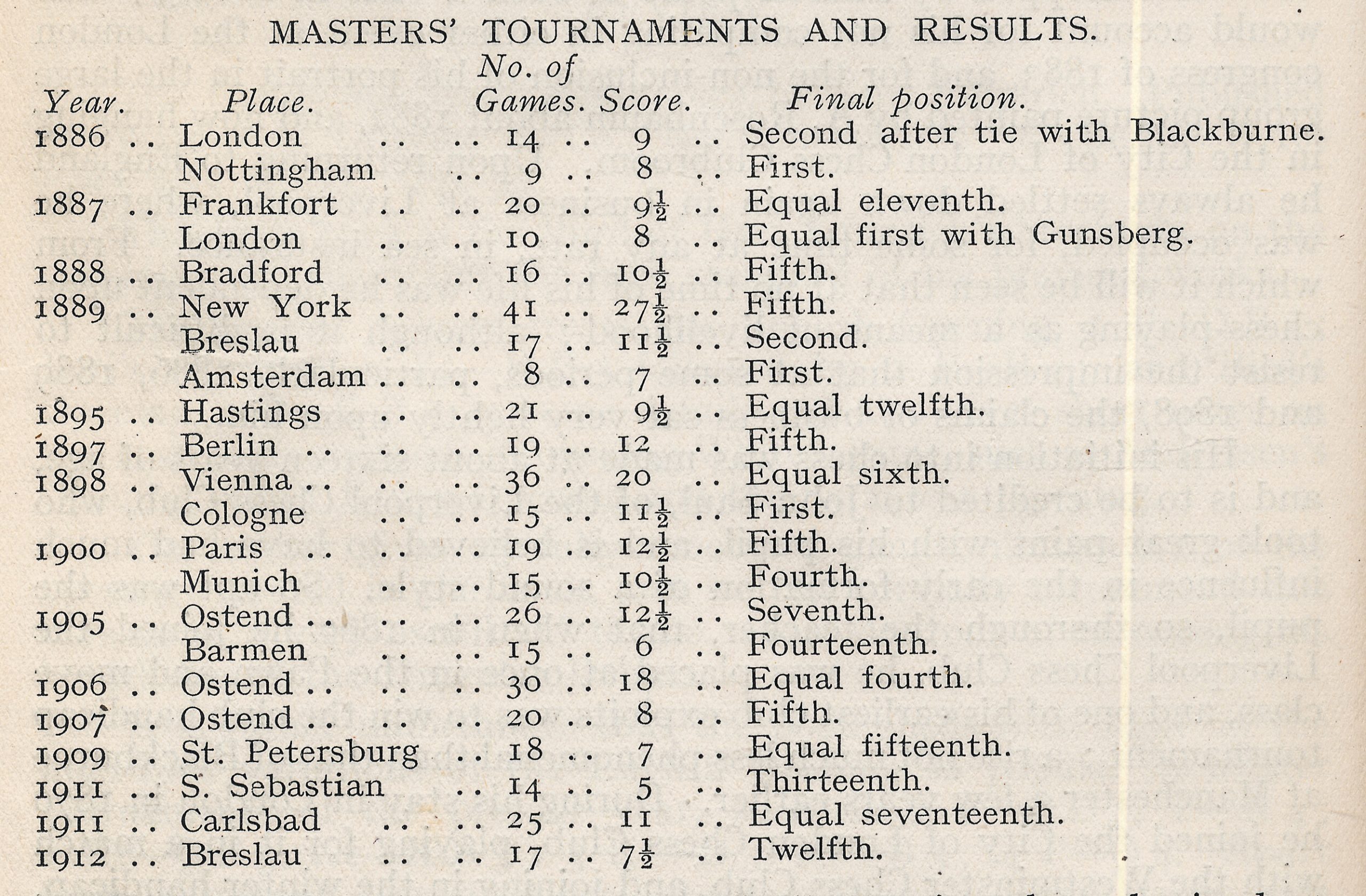
The greatest success was beyond all question that obtained at Cologne in 1898, where he was first to such renowned rivals as Charousek (second), Tchigorin (fourth), Steinitz (fifth) and Schlechter (equal sixth). But no mean place in the order of merit must be assigned to the second prize at Breslau in 18B9, where Dr. Tarrasch achieved the first of his great Series of successes, and such players as Bardeleben, Blackburne, Gunsberg, Mason and Schallopp were amongst the less successful competitors. The book of that tournament, in recognition of so striking a success, following upon the New York tournament with the Amsterdam victory treading closely upon its heels described Burn as the “tournament hero of the year”
In 1898 the Cologne tournament followed hard upon the long struggle at Vienna; these events of these two years go to prove his remarkable power of endurance : he fared best in the most prolonged. efforts.
During this period of international activity Burn did not altogether eschew competitors of a national or sectional character. Early in 1889 he won first prize in an Irish Chess Association tournament at Dublin, Pollock and Mason taking the next two places. In 1897-8-9 and 1901 he competed at Llandudno for the Craigside challenge cup, which he won three times in the four tournaments. He also won a Midland counties tournament at Birmingham in 1899, with Atkins second.
Of individual match play there is not much to record. A match with Bird in 1886 (two more opposed styles of play could hardly be imagined) was begun as one of five up, with the score at four all was extended to ten up, and was finally drawn by agreement with the score at at nine all. In the same year a match of five up with Captain Mackenzie was drawn with as score of four all; the curiosity of this
match is that Mackenzie won the first four games and Burn the last four. A match is known to have been played in 1875 with the Rev. John Owen, the leading player of the Liverpool club until Burn’s rise ; this Burn won by 11 to 6. Mr. Owen, however, told the present writer (about 1895) that he had contested several matches with Burn, who had not always been the winner; no record remains of these encounters; but as neither player had any love for the practice of recording the moves of a game during its progress its absence is not surprising. Similarly, a short match was begun with the Rev. A. B. Skipworth at his Lincolnshire rectory, somewhere in the late eighties, but whether finished is doubtful; probably the record of this is buried in the files of a Horncastle or Louth newspaper in which Mr. Skipworth conducted a chess column at the time.
Burn took part in the matches by cable with America on four occasions. In 1896 and 1898 he lost to Showalter; in 1907 he drew with Marshall; and in 1911 he defeated Marshall (who was then in London) over the board.
His connection with the Liverpool Chess Club lasted from 1867 until his death. He served the offices of librarian in 1877, vice-president in 1880, president in 1881, 1888, 1890, 1891, 1892, 1908, 1909, 1910 and 1911. In 1887 he was elected an honorary member retaining that qualification until then end. In 1888 he was presented by the club with a handsome chessboard and set of chessmen, the box bearing an inscribed silver plate, in recognition of the tournament successes he had already achieved, and as a token of the high esteem in which he was held by his fellow members.
As a chess journalist Burn commenced in 1871 when he edited
a column in the Liverpool Weekly Albion, how long this continued we do not know. In 1911 he became chess editor of the Liverpool Courier. His annotation of games for this column attracted wjde-spread notice and was much quoted both at home and abroad. When therefore, on the death in 1913 of Leopold Hoffer, Burn was appointed to The Field, it was to the general satisfaction of British chessplayers everywhere. His treatment of the games published in that paper was of the most sound and reliable character, and no pains were ever spared to arrive at the inner secret of the most intricate position. The high standard set by Steinitz when editing the same column thirty to forty years before, was worthily maintained by his quondam pupil on becoming his successor.
Burn’s style of play was solid and prudent rather than aggressive; he has more than once mentioned with pardonable pride that amongst his peers of master rank he was chiefly famed for “stubborn defence.” A favourite aphorism was, “The player who combinates is lost !” Nevertheless it is to be at least suspected that this was
the result of his early chess education and a strong power of self-control rather than of his predilections. An oft-repeated saying, perhaps the one which will be in London longest remembered, was “toujours attaque” ; his preference for being first player was stronger than that of most players, strong as that often is; and when shown
a game or position he had very little hesitation in taking sides, almost always with the attack; only with the defence when his initial judgment told him that unsoundness was afoot. But “counterattack is the soul of defence,” and in that he could be terrible. A collection of, say, twenty of his best games would probably yield a large pre-
ponderance of Black as his side. Once interested in a game (or position) his concentration upon it was of the most intense kind, and could only with difficulty be diverted. Even in skittle play, a cup of coffee, ordered at the start, would stand at his elbow unnoticed; was the opponent at some point long in moving he would suddenly become aware of its presence, and lift the cup; but let the opponent at the same instant raise his hand to move, back went the cup to the table untasted, and the beverage would be eventually consumed quite cold. His pipe fared little better; badly loaded, it took innumerable matches to light, was laid down after a few puffs, went out, and was
re-lit with the same difficulty. Did a friendly onlooker hint that a difference in the loading of the pipe would save much trouble, he would, if he succeeded in gaining attention, be quietly and painlessly extinguished with “How long have you been a smoker ?” The same intensity of concentration was carried into his work for the Field, and it is known that he often sat through the small hours of the morning to complete an analysis rather than interrupt the current of his ideas. Had he but spared himself in this respect —!
Of short figure, slight frame, and abstemious in habit, he was remarkably ” wiry ” ; at 77 his head of hair was quite untouched by the hand of time, and but for the grizzling of the beard he would have passed for no more than sixty. Perhaps a little difficult of approach by strangers, when his attention and interest were once gained he was the soul of courtesy, and would take unstinted trouble to oblige his interlocutor, or to help a colleague.
At the chessboard his courtesy to his opponent was perfect; he “played the game” in the best sense of the words; and his tribute to Blackburne’s chivalry as an opponent was worth the more because it accorded with his practise. With him passes the last of the line of English great masters!
In 2006 an article by WD Rubinstein was published in the Oxford Dictionary of National Biography
From The Oxford Companion to Chess (OUP, 1984), Hooper & Whyld :
“One of the world’s top ten players at the end of the 19th century. Born in Hull : he learned chess when 16, came to London at the age of 21, and rapidly established himself as a leading English player, A pupil of Steinitz, he developed a similar style; both he and his master were among the world’s best six defensive players, according to Nimzowitsch. Not wishing to become yet another impecunious professional. Burn decided to put his work (first a cotton broker then a sugar broker) before his chess, and he remained an amateur. He made several long visits to America, and was often out of practice when he played serious chess.
Until his thirty-eighth year he played infrequently and only in national events, always taking first or second prize. From 1886 to 1889 he played more often. In 1886 he drew matches with Bird (+9-9) and Mackenzie (+4=2-4); at London 1887 he achieved his best tournament result up to this time, first prize (+8—1) equal with Gunsberg (a play-off was drawn +1=3—1); and at Breslau 1889 he took second place after Tarrasch ahead of Gunsberg, After an isolated appearance at Hastings 1895 he entered another spell of chess activity, 1897-1901, The best achievement of his career was at Cologne 1898, first prize ( + 9=5-1) ahead of Charousek, Chigorin, Steinitz, Schlechter, and Janowski. At Munich 1900 he came fourth (+9=3—3). His Last seven international tournaments began with Ostend 1905 and ended with Breslau 1912. A comparative success, in view of his age. was his fourth prize shared with Bernstein and Teichmann after Schlechter, Maroczy, and Rubinstein at Ostend 1906; 36 players competed in this five-stage event, 30 games in all for those who completed the course.
Retired from both business and play he made his home in London and edited the chess column of The Field from 1913 until his death. A shy and retiring man, a loyal companion to those who came to know him, he freely gave advice to young and aspiring players.”
The front cover of the November 1975 issue of the British Chess Magazine featured Amos Burn :
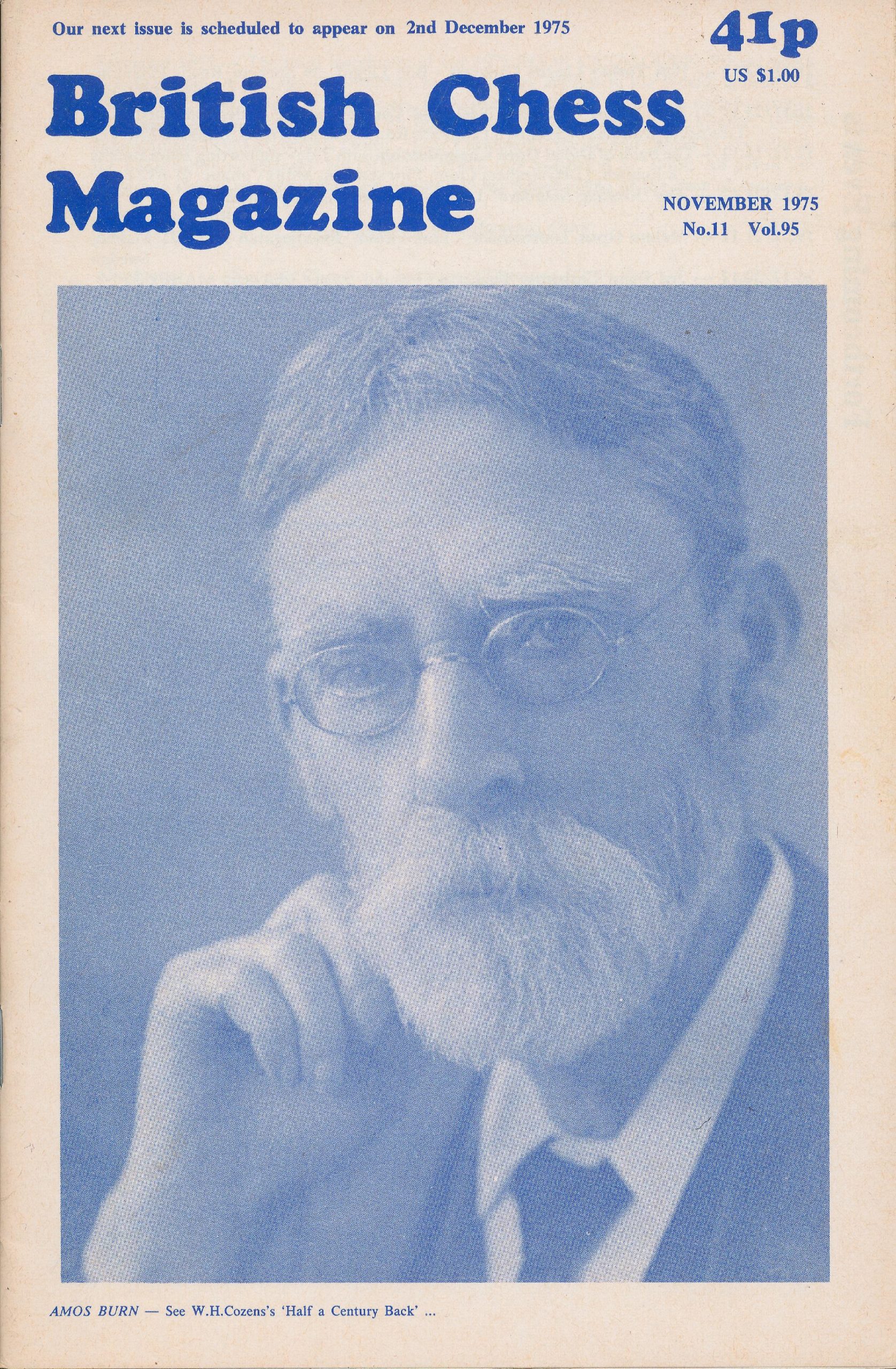
From British Chess Magazine, 1975, November, pp. 481-483 :
Half a Century Back
Chess in 1925
by W.H. Cozens
Amos Burn was a very different figure and his career is poorly documented. He is overdue, not for a reappraisal but simply an appraisal, He was born (in Hull) in 1848 – an incredible 127 years ago. All the years that could have been his prime as a chessplayer he devoted to business. (Marine insurance was his speciality.) He was based in Liverpool but travelled considerably, including several crossings of the Atlantic – quite an undertaking in those days. He played some casual chess, soon overshadowing the Rev. John Owen to become Liverpool’s answer to Manchester’s Blackburne. He also played for the City of London Chess Club; but it was not until he was nearly 40, presumably with his financial position secured, that he entered the international chess arena. Between the ages of 38 and 64 he played in 22 international tournaments. At Breslau (1889) he was second to Tarrasch, above Louis Paulsen, Blackburne, Schallop … In Amsterdam the same year he was first, ahead of Emanuel Lasker. His finest achievement was first place at Cologne 1898, in front of Charousek, Chigorin, Steinitz, Schlechter et al., (16 in all) with a win against Steinitz. The lack of a book on Cologne 1898 is – since the publication of Mannheim 1914′: the biggest gap in tournament literature.
At Karlsbad 1911 he defeated not only the winner, as mentioned above, but also Alekhine, whom he steered into a knight versus bad bishop ending. His style was unashamedly modelled on that of Steinitz, and marked by extreme tenacity. To him is attributed the epigram ‘He who combinates is lost’. He could play a combination when in the mood but he much preferred to let the opponent break his own back by attacking too impetuously. Nimzowitsch wrote: ‘The number of really great defensive players is very small’, adding that he knew of only six: Steinitz, Emanuel Lasker, Burn, Bernstein, Duras and Louis Paulsen.
In the 1911 Cable Match between G.B. and the U.S.A. Marshall came from San Sebastian straight to London and asked permission for his top board game to be played over the board. When he found that his opponent was to be the 64-year-old Amos Burn he must have smiled, for he had twice defeated him resoundingly – at Paris 1900 (also having some fun at Burn’s expense in his annotations to the game) and again at Ostend 1905. This time he was in for a shock. Within twenty moves the old man had won his queen for two pieces. Marshall played on, probably with a red face, until move 37, rather than have his loss cabled home too early. Against Burn he might have spared himself the trouble.
Burn was a superb annotator. His work, notably in ‘The Field‘ from 1913 on, sets a standard to which one looks back nostalgically in these days of hieroglyphics. The day before he died, at the age of 77,he had been at work on analysis and annotation. Tournaments were now plentiful enough for it to be possible to pick out the band of regular professionals, and to assess their prowess. Tartakower was placed 2, 5, l, 5; Reti 5, 5’ 5,-11; Grunfeld 4,8,8,9; Nimzowitsch was erratic with 1,2,9; so was Rubinstein with 1, 2, 3, 12. Marshall was consistent with 3, 4, 5. Lasker, Capablanca and Alekhine appeared once each – with distinction, of course.”
The Burn Variation is a line in the french defence dating from the 1870s, played regularly by Burn at the tournaments of Hastings
1895, Cologne 1898, and Vienna 1898. More recently it has been favoured by Petrosyan.
From The Encyclopedia of Chess (Robert Hale, 1970 & 1976), Anne Sunnucks :
“A leading British player of his day, Amos Burn was born in Hull on 31st December 1848. He learned the game when he was 16 and an apprentice with a firm of Liverpool cotton-brokers, but it was not until 1886 that he achieved his first major tournament success by coming 2nd in the London tournament and 1st at Nottingham. These results gained him an invitation to Frankfurt 1887, which marked the beginning of his career as an international player.
Burn’s greatest successes were 1st at Amsterdam 1889, ahead of Lasker, 2nd at Breslau 1889, behind Tarrasch but ahead of Mieses, Von Bardeleben, Bauer, Gunsberg and Paulsen; and 1st at Cologne 1898, ahead of Charousek, Steiniitz, Tchigorin and Schlecter.
After the St. Petersburg 1909 tournament, Burn’s results began to deteriorate and he finally retired from tournament chess after the Breslau 1912 tournament.
From 1913 until his death, Burn was chess editor of The Field. He died on 25th November 1925.”
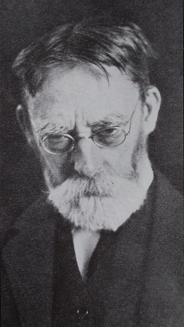
From The Encyclopedia of Chess (Batsford, 1977), Harry Golombek OBE :
“British Grandmaster and second only to Blackburne in late nineteenth-century British chess. He was born in Hull and learned to play chess at sixteen, but devoted little time to the game at first, preferring to establish himself in a commercial career.
He returned to chess in his middle thirties, his first major national success being first prize at Nottingham 1886 and second prize at London 1886. Within three years he had gained an international reputation by winning at Amsterdam 1889, ahead of Lasker, and finishing 2nd to Tarrasch at Breslau 1889. Burn continued to appear in international tournaments until the age of sixty-four, his most notable triumph being first prize at Cologne 1898 in front of Charousek, Steinitz, Chigorin and Schlechter. He was chess editor of The Field from 1913 until his death in 1925.”
Edward Winter wrote a feature article on the game McDonald-Burn, Liverpool, 1910
and from that game we have the move that made that game memorable :
Black to move : did you find it? (if not see the foot of this article)
William Winter wrote the following in the February issue of CHESS for 1963, (Volume 28, Number 426, pp.128-134):
“For my win over Niemtsovich I am partly indebted to Amos Burn. Before the tournament I happened to mention to him that Niemtsovich was playing a system, beginning with 1.P-QN3, the idea of which was to control the square at his K5 from the flank, and eventually occupy it with a knight. The old master told me that in his younger days he had played many games with the Rev. John Owen who regularly adopted this opening, and that he could make little headway against it, until he hit on the idea of at once occupying the key square with a pawn and defending it with everything he could pile on. This plan I adopted with complete success. After my third move I saw Niemtsovich shake his head, and in fact he was never comfortable.”
According to Edward Winter in Chess Notes Burn lived at 19 Luxemburg Gardens, London W6, England (Amos Burn, The Quiet Chessmaster by R.N. Coles, page 7).
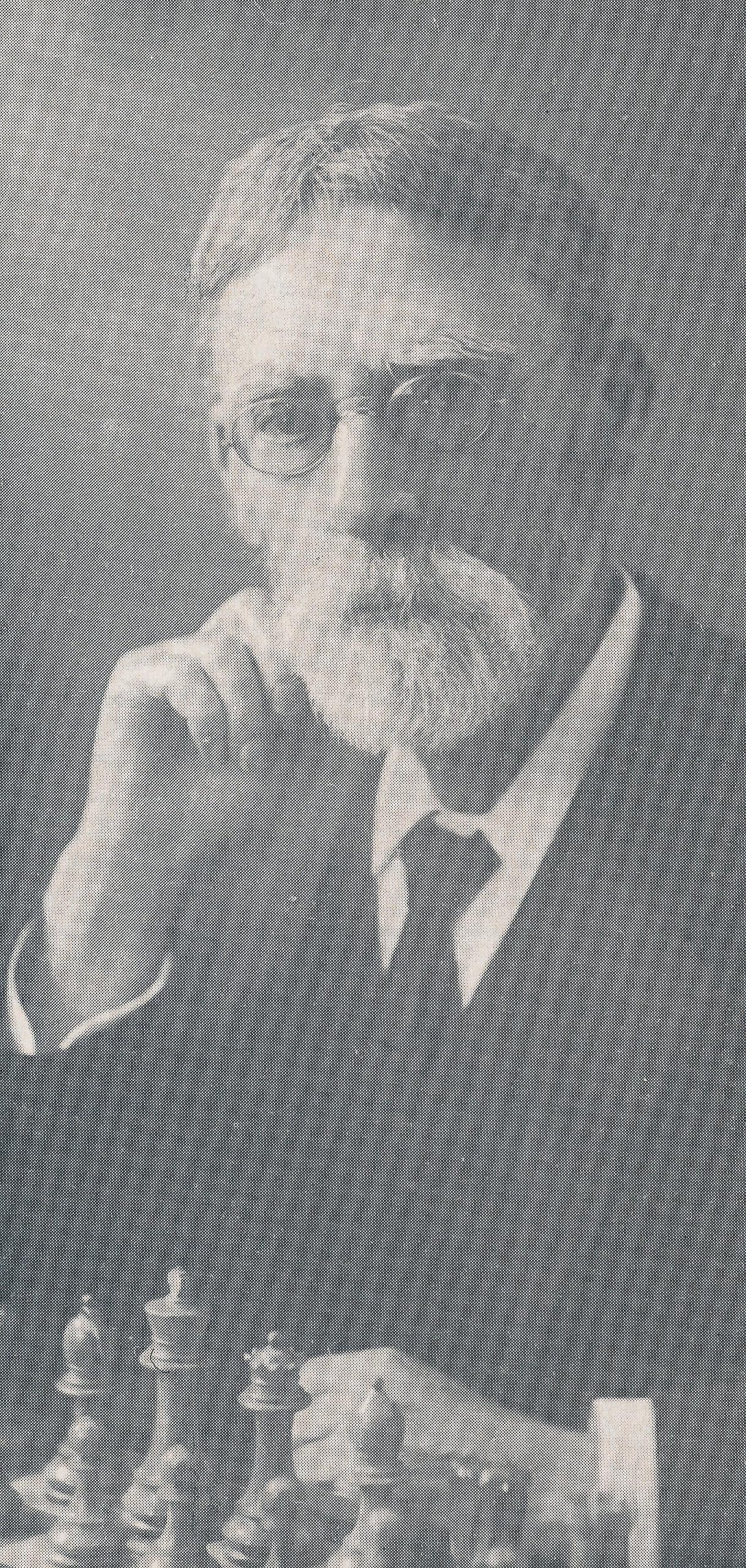
and an excellent article from the Liverpool Museum is here
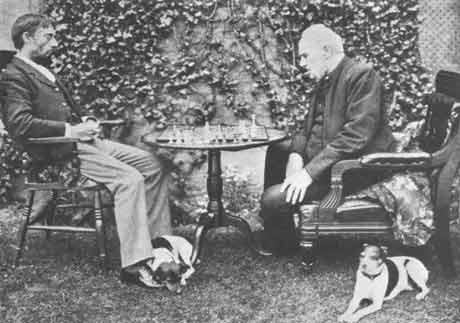


and in case you did not spot the move : Burn played 33…Qg4!!

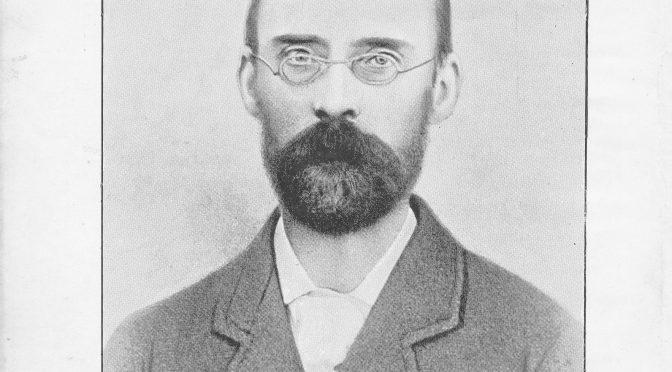
5 thoughts on “Remembering Amos Burn (31-xii-1848 25-xi-1925)”